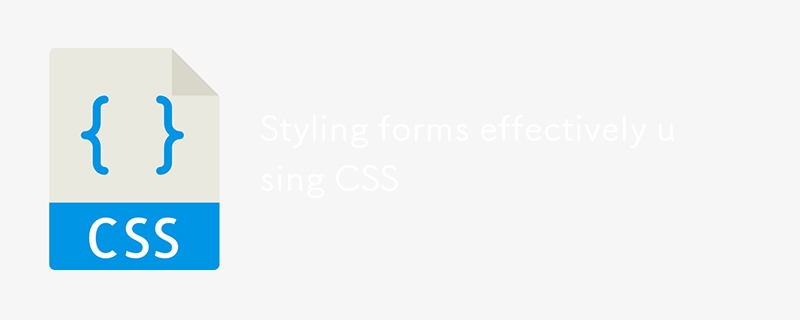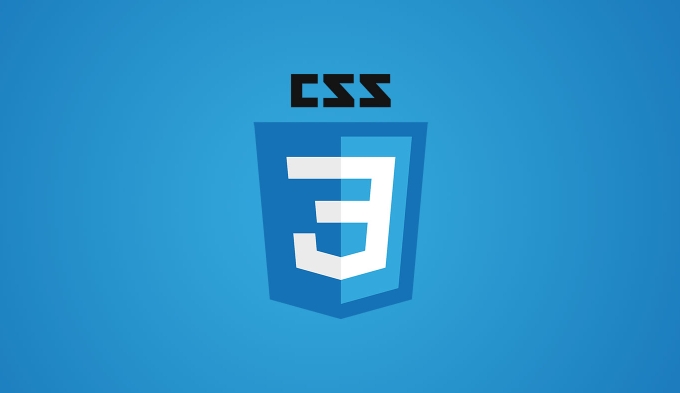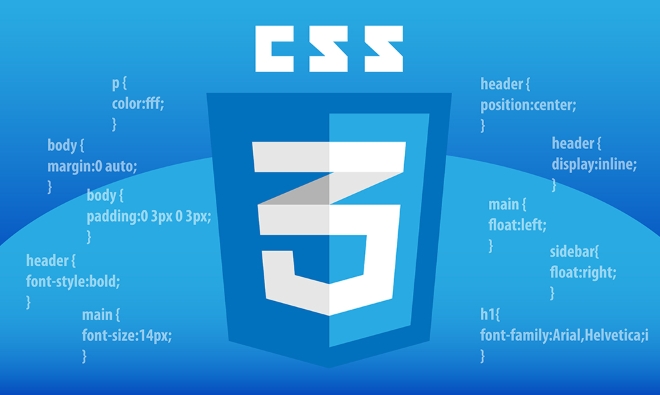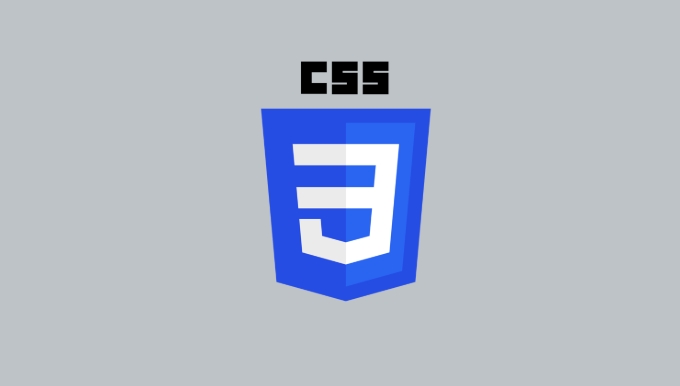Style the form through CSS to improve user experience and unify the page style. The specific methods are as follows: 1. Use universal reset styles to unify the appearance of form elements, and use flex or grid layout to optimize the structure to make the form items clearly arranged; 2. Use pseudo-classes such as: focus, :hover, :invalid and :valid to enhance state feedback and improve interactive intuitiveness; 3. Use native controls to hide native controls and simulate custom controls (such as check boxes) to improve visual consistency and better match the overall design style.

Forms are an important part of web interaction, but the default browser styles tend to appear monotonous and unattractive. Style the form through CSS, which not only improves the user experience, but also makes the overall style of the page more unified. The key is to master structure, state and detail control.

1. Basic style reset and layout optimization
The styles of form elements that come with the browser are quite different. It is recommended to use a general reset style to unify the appearance:

input, select, textarea {
border: 1px solid #ccc;
border-radius: 4px;
padding: 8px;
font-size: 16px;
outline: none;
}At the same time, a reasonable layout can improve readability and usability. You can use flex or grid to align labels and input boxes, such as:
.form-group {
display: flex;
flex-direction: column;
margin-bottom: 16px;
}
.form-group label {
margin-bottom: 8px;
}This allows each form item to be arranged clearly, making it easier for users to read and operate.

2. Status feedback enhances interactive experience
A good form should clearly reflect the user's operation status. You can set styles in different states through pseudo-class selector:
-
:focus: Highlight the field currently being entered -
:hover: Provide hover feedback -
:invalidand:valid: Show verification status
For example:
input:focus {
border-color: #007BFF;
box-shadow: 0 0 0 2px rgba(0,123,255,0.25);
}
input:invalid {
border-color: red;
}These small details make it easier for users to understand the current operation stage and also improve the intuitiveness of error prompts.
3. Custom controls improve visual consistency
Some native controls (such as <select> and <input type="checkbox"> ) perform inconsistently under different systems, and directly customizing them can improve visual unity. A common method is to hide native controls and emulate their functions with HTML CSS.
Take the check box as an example:
<label class="custom-checkbox"> <input type="checkbox" /> <span class="checkmark"></span> Agree to terms</label>
Cooperate with CSS:
.custom-checkbox input {
display: none;
}
.checkmark {
width: 16px;
height: 16px;
border: 1px solid #999;
border-radius: 3px;
display: inline-block;
position: relative;
}
input:checked ~ .checkmark {
background-color: #007BFF;
border-color: #007BFF;
}This method gives you complete control over the appearance of the controls and better match the overall design style of the website.
Basically that's it. The form style design seems simple, but to take into account compatibility, usability and aesthetics, you still need to spend more time on details.
The above is the detailed content of Styling forms effectively using CSS. For more information, please follow other related articles on the PHP Chinese website!

Hot AI Tools

Undress AI Tool
Undress images for free

Undresser.AI Undress
AI-powered app for creating realistic nude photos

AI Clothes Remover
Online AI tool for removing clothes from photos.

Clothoff.io
AI clothes remover

Video Face Swap
Swap faces in any video effortlessly with our completely free AI face swap tool!

Hot Article

Hot Tools

Notepad++7.3.1
Easy-to-use and free code editor

SublimeText3 Chinese version
Chinese version, very easy to use

Zend Studio 13.0.1
Powerful PHP integrated development environment

Dreamweaver CS6
Visual web development tools

SublimeText3 Mac version
God-level code editing software (SublimeText3)

Hot Topics
 What is 'render-blocking CSS'?
Jun 24, 2025 am 12:42 AM
What is 'render-blocking CSS'?
Jun 24, 2025 am 12:42 AM
CSS blocks page rendering because browsers view inline and external CSS as key resources by default, especially with imported stylesheets, header large amounts of inline CSS, and unoptimized media query styles. 1. Extract critical CSS and embed it into HTML; 2. Delay loading non-critical CSS through JavaScript; 3. Use media attributes to optimize loading such as print styles; 4. Compress and merge CSS to reduce requests. It is recommended to use tools to extract key CSS, combine rel="preload" asynchronous loading, and use media delayed loading reasonably to avoid excessive splitting and complex script control.
 External vs. Internal CSS: What's the Best Approach?
Jun 20, 2025 am 12:45 AM
External vs. Internal CSS: What's the Best Approach?
Jun 20, 2025 am 12:45 AM
ThebestapproachforCSSdependsontheproject'sspecificneeds.Forlargerprojects,externalCSSisbetterduetomaintainabilityandreusability;forsmallerprojectsorsingle-pageapplications,internalCSSmightbemoresuitable.It'scrucialtobalanceprojectsize,performanceneed
 Does my CSS must be on lower case?
Jun 19, 2025 am 12:29 AM
Does my CSS must be on lower case?
Jun 19, 2025 am 12:29 AM
No,CSSdoesnothavetobeinlowercase.However,usinglowercaseisrecommendedfor:1)Consistencyandreadability,2)Avoidingerrorsinrelatedtechnologies,3)Potentialperformancebenefits,and4)Improvedcollaborationwithinteams.
 CSS Case Sensitivity: Understanding What Matters
Jun 20, 2025 am 12:09 AM
CSS Case Sensitivity: Understanding What Matters
Jun 20, 2025 am 12:09 AM
CSSismostlycase-insensitive,butURLsandfontfamilynamesarecase-sensitive.1)Propertiesandvalueslikecolor:red;arenotcase-sensitive.2)URLsmustmatchtheserver'scase,e.g.,/images/Logo.png.3)Fontfamilynameslike'OpenSans'mustbeexact.
 What is Autoprefixer and how does it work?
Jul 02, 2025 am 01:15 AM
What is Autoprefixer and how does it work?
Jul 02, 2025 am 01:15 AM
Autoprefixer is a tool that automatically adds vendor prefixes to CSS attributes based on the target browser scope. 1. It solves the problem of manually maintaining prefixes with errors; 2. Work through the PostCSS plug-in form, parse CSS, analyze attributes that need to be prefixed, and generate code according to configuration; 3. The usage steps include installing plug-ins, setting browserslist, and enabling them in the build process; 4. Notes include not manually adding prefixes, keeping configuration updates, prefixes not all attributes, and it is recommended to use them with the preprocessor.
 What are CSS counters?
Jun 19, 2025 am 12:34 AM
What are CSS counters?
Jun 19, 2025 am 12:34 AM
CSScounterscanautomaticallynumbersectionsandlists.1)Usecounter-resettoinitialize,counter-incrementtoincrease,andcounter()orcounters()todisplayvalues.2)CombinewithJavaScriptfordynamiccontenttoensureaccurateupdates.
 CSS: When Does Case Matter (and When Doesn't)?
Jun 19, 2025 am 12:27 AM
CSS: When Does Case Matter (and When Doesn't)?
Jun 19, 2025 am 12:27 AM
In CSS, selector and attribute names are case-sensitive, while values, named colors, URLs, and custom attributes are case-sensitive. 1. The selector and attribute names are case-insensitive, such as background-color and background-Color are the same. 2. The hexadecimal color in the value is case-sensitive, but the named color is case-sensitive, such as red and Red is invalid. 3. URLs are case sensitive and may cause file loading problems. 4. Custom properties (variables) are case sensitive, and you need to pay attention to the consistency of case when using them.
 What is the conic-gradient() function?
Jul 01, 2025 am 01:16 AM
What is the conic-gradient() function?
Jul 01, 2025 am 01:16 AM
Theconic-gradient()functioninCSScreatescirculargradientsthatrotatecolorstopsaroundacentralpoint.1.Itisidealforpiecharts,progressindicators,colorwheels,anddecorativebackgrounds.2.Itworksbydefiningcolorstopsatspecificangles,optionallystartingfromadefin






